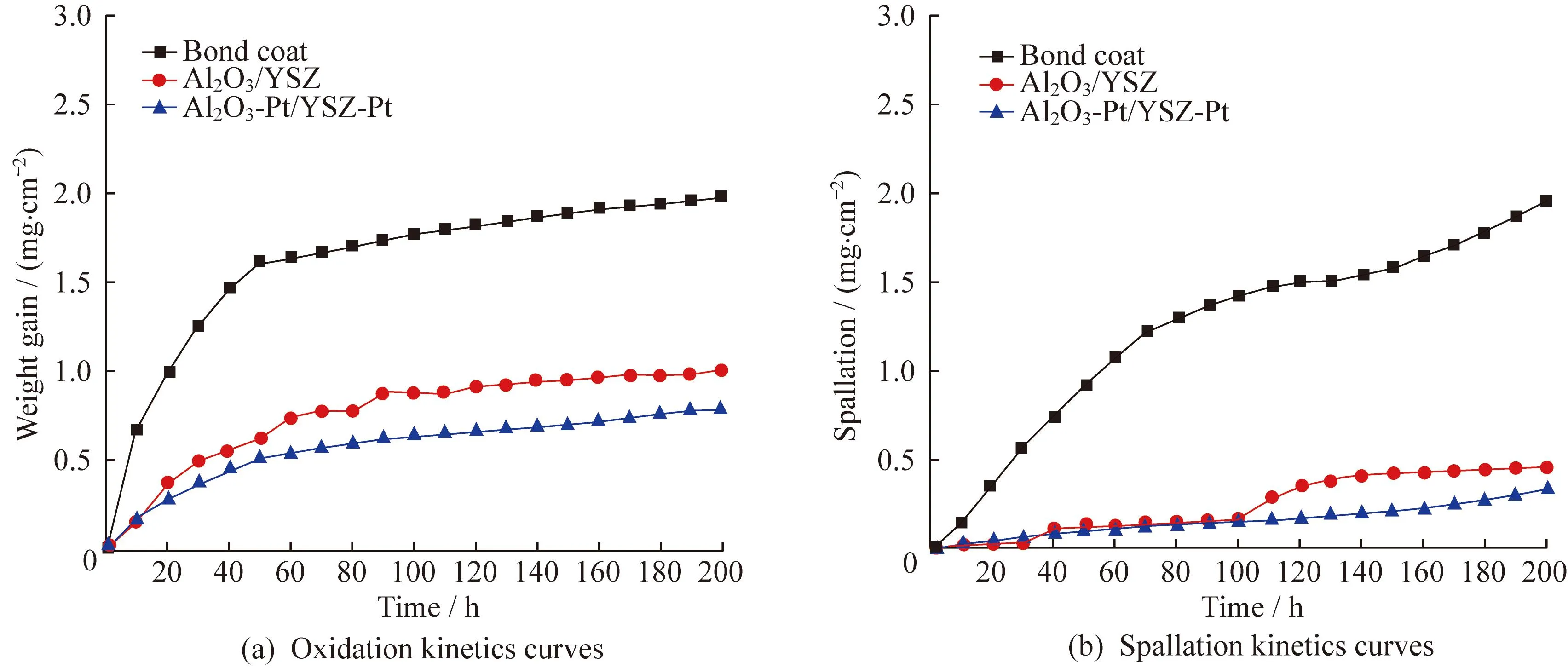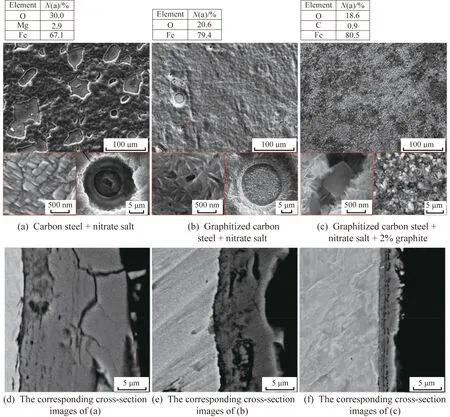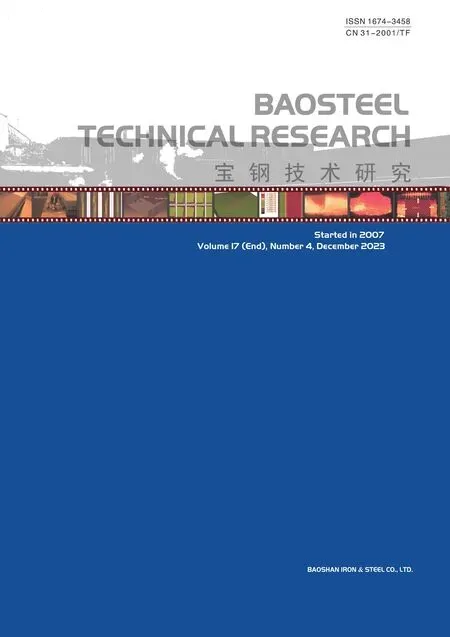Research progress on protective coatings against molten nitrate salts for thermal energy storage in concentrating solar power plants
, , , , é,
1)Baowu Carbon Technology Co.,Ltd.,Shanghai 201999,China;2)Birmingham Centre for Energy Storage &School of Chemical Engineering,University of Birmingham,Birmingham B15 2TT,United Kingdom
Abstract:Concentrating solar power (CSP) has garnered considerable global attention as a reliable means of generating bulk electricity,effectively addressing the intermittent nature of solar resources.The integration of molten salt technology for thermal energy storage (TES) has further contributed to the growth of CSP plants;however,the corrosive nature of molten salts poses challenges to the durability of container materials,necessitating innovative corrosion mitigation strategies.This review summarizes scientific advancements in high-temperature anticorrosion coatings for molten nitrate salts,highlighting the key challenges and future trends.It also explores various coating types,including metallic,ceramic,and carbon-based coatings,and compares different coating deposition methods.This review emphasizes the need for durable coatings that meet long-term performance requirements and regulatory limitations,with an emphasis on carbon-based coatings and emerging nanomaterials.A combination of multiple coatings is required to achieve desirable anticorrosion properties while addressing material compatibility and cost considerations.The overall goal is to advance the manufacturing,assembly,and performance of CSP systems for increased efficiency,reliability,and durability in various applications.
Key words:anticorrosive coating; high temperature; molten salt; concentrated solar power; thermal energy storage
1 Introduction
Concentrating solar power (CSP) has garnered remarkable interest among researchers,power-pro-ducing companies,and state policymakers for its bulk electricity generation capability,effectively mitigating the intermittent nature of solar resources.The two primary CSP systems,namely the parabolic trough collector and solar power tower,are currently either operational or in the construction stage.USA and Spain are the global leaders in CSP electricity generation,and developing countries such as China and India are rapidly deploying CSP technologies to meet net zero targets.
CSP plant installation has soared since 2010,with their installation capacity experiencing a substantial increase from 1 GW up to almost 5 GW in 2016 through integrated storage (mainly molten salt tech-nology).The adoption of CSP technology continues to grow,and its prospects for the future are highly promising.CSP global operation accounts for 6 128 MW installed,157 MW under construction,and 1 592 MW under development and is distributing clean energy in more than a dozen countries.The largest CSP plant in the world to date is situated in Morocco:a 580 MW capacity system built in three phases.In China,the status of CSP is 596 MW operational and 2.4 GW under construction or development[1].China aims to emerge as the global leader in CSP electricity generation by 2025.Fig.1 shows the concentrated solar power development path from 1982 to 2030[2].

Fig.1 Concentrated solar power development path from 1982 to 2030
Molten salts have been used as thermal energy storage (TES) material and heat transfer fluid with the aim of increasing the capacity factor of the power plant,allowing for the production of electricity after sunset.TES systems in CSP plants are integrated with two individual storage tanks (i.e.,cold tank and hot tank),which enable the use of sensible heat from molten salts as the storage medium.In the two-tank indirect configuration,synthetic oil is used as the heat transfer fluid in the solar collectors,and molten salts are used as sensible storage material in the cold (290 ℃) and hot (390 ℃) tanks.In the two-tank direct con-figuration,molten salts are used as the heat transfer fluid in the solar receiver and as sensible storage material in the cold (290 ℃) and hot (565 ℃) tanks.For both configurations,the thermal stability of the heat transfer fluid limits the maximum operating temperature of the storage system and,consequently,the steam turbine for power gener-ation.With high achievable temperatures,the two-tank direct configuration can provide the largest storage capacity for a given quantity of molten salts and increase the thermodynamic efficiency of the power block.Consequently,recent CSP projects under construction or development are based on this two-tank direct system (e.g.,solar power tower plants).
A typical CSP plant uses approximately 28 000 tons of molten nitrate salts divided into two steel tanks,each measuring >20 m in diameter.The cold tank is generally composed of carbon steel,and the hot tank is composed of austenitic stainless steel.Molten nitrate salts are transported across the plant via stainless steel pipes,and heat exchangers are either composed of ferritic-martensitic or austenitic stainless steels.With the rapid development of CSP technology in China and around the world,large volumes of steel will be required to build the plants.However,the durability of steel can be compromised due to the corrosive nature of molten salts.Thus,the corrosion of container materials in contact with molten nitrate salts in high-temperature environments is of great technological interest.Although molten salt technology has been used for decades,research on the high-temperature corrosion of materials and components is still in the deve-loping phase.In addition,the 30-year technical lifetime for CSP plants must be taken into account for corrosion implications.Therefore,corrosion mitigation strategies are necessary for the improved durability of container materials.Novel strategies have been proposed for the innovation of corrosion-resistant coatings:
Active-passive:the protective coating acts as a barrier layer that prohibits the permeation of cor-rosive agents to the underlying metal surface (passive);
Smart coatings:systems that can provide infor-mation about their thickness and defects[3];possess the ability to respond to an external stimulus,such as heat,stress,strain,or corrosive environmental factors;and are able to repair themselves when damaged;
Self-healing organic components[4-5]:these com-ponents can self-recover the initial properties of the material after the destructive action of the external environment;examples include loading of corrosion inhibitors,nanocontainers with metal oxide particles as the sacrificial core,and doping/adsorption of the corrosion inhibitors on the surface;
Coatings with time-release techniques[6]:coatings that provide enhance corrosion resistance while being cheap,nontoxic,and able to withstand harsh condi-tions,with the additional benefit of long service life.
The market of corrosion coating is currently driven by organic and inorganic growth strategies,with the aim of attaining large market dominance.The newly emerging types of 2D nanomaterials provide a potential solution to realize the high dispersion of 2D nanomaterials in organic coat-ing[7].Such coatings are primarily based on poly-mer composites[8-12],graphite[13],or hybrid[13].How-ever,not all of these techniques have been applied to medium-to high-temperature coatings.
This review aims to summarize the main scientific advances in anticorrosive coatings for high-temper-ature molten nitrate salts,assess the most challenging aspects of these coatings,and highlight future trends.
2 Corrosion in CSP/molten salt technology
Corrosion is a topic of great interest in current societies because,in addition to the economic costs and technological challenges,this phenomenon leads to structural failures that can have dramatic con-sequences for humans and the environment[14].The annual costs related to corrosion and corrosion pre-vention constitute a significant part of the worldwide economy and reach a total amount of $ 2.2 trillion,3% of the world’s GDP[15].Corrosion is the reac-tion of a metallic material with its environment,with solid,liquid,or gas as byproducts.The physical and chemical characteristics of these byproducts may influence the rate of reaction[16].Corrosion occurs when a metal combines with an atom or a molecular group and loses electrons,i.e.the metal is oxidized, while another species is reduced.
The corrosion of high-temperature molten salt can be represented as an acid/base model similar to the one used in aqueous corrosion.In molten salts,negatively charged ions rather than positively charged hydrogen ions are usually considered.The acid/base model defines the parameters and con-ditions under which corrosion occurs.In molten nitrate salts,the corrosion mechanism is described by oxyanionic salt reactivity:
(1)

(2)
When thew(O2-) level is high,the environment is considered acidic.Therefore,the dissolution of the metal oxide (MxOy) will result in oxide ions and potentially soluble metal ions:
MxOy?xM2++yO2-
(3)
3 Protective coatings
Anticorrosion coatings operate through several mechanisms,which can be categorized into three types:barrier creation between metallic substrate materials and the surrounding environment,inhi-bition of corrosion,and a coating acting as a sacri-ficial material,such as an anodically active metal coat-ing[17].Barrier protection coatings cause oxygen depri-vation or resistance inhibition.Inhibitive coatings alter the chemistry of the metal substrate surface.Anodically active metal coatings are selected due to their anodic activity level;they can prevent elec-trical current from discharging from the substrate and causing galvanic corrosion.Corrosion coatings must adhere to several requirements,such as dur-ability,easy application,environmental friendliness,cost-effectiveness,and high performance.These re-quirements have prompted the development of novel coating systems,including methods and composi-tions.The topic of protecting metals and alloys using coatings has been a highly relevant and extensively explored area in the field of materials science for several years.Over long periods,changes in regulatory laws protecting the environment and human health have imposed limitations on the use of dangerous compounds,such as volatile organic compounds,hazardous air pollutants,and hexavalent chromium.In addition to the lack of alternative materials that can achieve all technical require-ments,these limitations have opened the path to the development of new coating materials.China is one of the countries with a high research interest and where many studies have been published (Fig.2).

Fig.2 Publication numbers per year on metal protection coatings (data accessed from Scopus on 08/06/2023)
3.1 Coating deposition
A wide range of coating methods exists due to the vast diversity in coating materials and applications across various fields.These methods yield different outcomes in terms of material microstructure,effectiveness,suitability,and durability.They are particularly valuable in specific applications,with corrosion and wear protection being of utmost im-portance.The coefficient of thermal expansion (CTE) of the coating should be similar to that of the substrate,allowing the coating to endure thermal variations during the heating and cooling cycles of different processes[18].In high-temperature conditions,where corrosive gaseous and molten phases may be present,characteristics such as a dense coating structure and high adherence to the substrate are of utmost importance.
Although many deposition processes are avail-able,only a few are effective and applicable.These techniques range from a simple brush for painting to some complex and costly processes in the electro-nics industry.These methods include physical vapor deposition,chemical vapor deposition (CVD),micro-arc oxidation,sol-gel,thermal spray,and poly-mer coatings[19].Each of these approaches is suitable for different applications because they offer dif-ferent deposition methods,different materials,second phases,and different thicknesses and den-sities.Hence,the mechanical stability,corrosion properties,and enhancement of material behavior for a specific type of coating must be carefully con-sidered.Coating deposition is used to enhance surface properties without changing the chemical composition of the bulk materials.The most com-mon surface coating techniques are vapor deposi-tion,electrochemical coatings,thermal spraying,conversion coating,physical coating,and surface modification;each technique possesses its own set of advantages and disadvantages (Fig.3).These methods can be tailored to meet the specific require-ments of diverse applications.

Fig.3 Coating deposition techniques
3.2 Coating materials
Alloys with protective layers can be exposed to molten salts in liquid and vapor phases,leading to severe corrosion depending on the working conditions of the CSP plant component.Numerous anticorrosive coatings have been developed and tested to combat the harmful effects of corrosion on the alloys.Owing to the variations in the physical and chemical properties of different metal and alloy substrates,the protection provided by each coating is dependent on the type of metal and the envir-onment to which the coating is exposed.Another important aspect is the selection of appropriate coat-ing material,as it is crucial in successfully pro-viding all protection purposes.Several different materials,including metals,ceramics,polymers,and carbon-based materials,have been used to form a protective layer.The commonly applied ones are Al,Ti,Hf,Zr,Ni,Co,Pt,MgO,ZrO2,Al2O3,Y2O3,BeO,polyether ether ketone,and polytetrafluo-roethylene.Other materials,such as organic coatings alone,cannot provide long-term high-temperature corrosion protection due to thermal/chemical de-composition under elevated temperatures and cor-rosive environments.Moreover,pores are created inside the polymer matrix during curing due to the evaporation of organic solvents and external environmental stresses.These micropores provide a path for the diffusion of corrosive agents.To address this issue,fillers are incorporated into the polymer matrix to overcome the pore disadvantage and enhance the barrier performance[20].Different types of nanofillers,such as inorganic nanoma-terials[21-22],layered doubled hydroxides[23-25],and graphene-based nanomaterials[26-30],have been used to develop polymer nanocomposites with enhanced properties.These fillers can improve the barrier pro-tection of polymer coatings and decrease the permeability of aggressive species into the coatings.
Fig.4 shows the number of publications related to medium-and high-temperature corrosion coatings.Overall,metallic-based coatings have been naturally studied and extensively applied to different indu-stries.In recent years,carbon-based coating and its derivatives have emerged with exceptional pro-perties.

Fig.4 Publication numbers in the last decade on different coatings for hot corrosion (data accessed from Scopus on 08/06/2023)
The composition of anticorrosive coatings for high-temperature applications is reviewed in the following three sections:metal-based,ceramic,and carbon-based coatings.
3.2.1 Metallic coatings
Metallic coatings have been widely used to pro-tect against metal corrosion.Al and its alloys have been used as coatings because of their high tendency to form oxides and develop a passivation layer that inhibits corrosion kinetics.SHIMPALE et al.[31]proposed an Al slurry coating that is effec-tive against nitrate salts at 580 ℃ and carbonate salts at 650 ℃.Al diffusion coatings are commonly employed for high-temperature oxidation and cor-rosion protection in power generation and aeronautic gas turbine fields.Aluminized steel also offers good protection in metal dusting environments for several years of service[32].Through modification with Cr deposited by pack cementation or Pt deposited by electrodeposition,the lifetime and operating temper-ature of the coated alloy can be increased con-siderably[33].This type of coating has shown good behavior in protecting steels and Ni-based alloys.
Table 1 gives examples of coating compositions,especially for CSP anticorrosion studies in the last 5 years.High-chromium Ni-based alloys and aust-enitic steels have lower corrosion rates in molten salts compared with low-chromium steels[34-37].Cr enrichment leads to the growth of highly adherent inner Cr-rich oxide phases during exposure,dec-elerating the overall scale growth and Cr loss to the electrolyte.Applying heat treatment after coating deposition further improves the anticorrosion beha-vior[38].However,the influence of Cr on molten salt oxidation behavior is controversial.High-chromium alloyed steels show high corrosion protection via the formation of slow-growing continuous chromium oxide or chromite spinel layer[38-39].However,chro-mium depletion in the substrates and Cr dissolution in molten salt (albeit slow) have been obser-ved[40].In addition,Al-Cr and Al-Ni coatings had better corrosion behavior than pure Al coatings[40-41].
3.2.2 Ceramic coatings
Ceramics have been extensively used as thermal barrier coatings (TBCs),which are highly advan-ced materials (such as silica,yttria,alumina,tita-nia,and chromium oxide) used as coatings for pro-tection against high temperatures due to their highthermal stability,high hardness,and low thermal conductivity[44-46].They can be applied on the sub-strate (metal or alloy) as a thin layer enhancing the substrate’s thermal,mechanical,and/or chemical properties.In addition to chemical compatibility with the substrate,one of the main challenges for ceramic coatings is tolerance to high thermal stress and oxidizing environments.In some applications,ceramic coatings consist of more than one layer,one of which could consist of a metallic bond coat (usually MCrAlY,M=Ni,Fe,Co) to accom-modate CTE mismatch between the alloy and the ceramic coating[47].

Table 1 Metallic coating in different molten salt environments for CSP application
Cr3C2-NiCr coatings have high corrosion and ero-sion resistance at high temperatures up to 900 ℃;the corrosion resistance is provided by the NiCr matrix,and the erosion resistance is attributed to the formation of the carbide ceramic phase.The CTE of Cr3C2is almost similar to that of nickel and iron,which helps minimize the stress generated during thermal cycling in actual boiler environments.Ther-mal spray coatings are porous and have the dis-advantage of introducing local microcracks or high porosity[48-50].Corrosive fluids can then attack the substrate through these cracks[51-53].The mech-anical properties of these coatings are downgraded due to their high porosity,which in turn reduces their corrosion resistance.
Another example of ceramic coating material is alumina.Alumina coatings for metal surfaces are used due to their good thermal stability,chemical inertness,and mechanical,optical and electrical pro-perties.Alumina is found in different crystal forms,such as α-Al2O3,γ-Al2O3,and θ-Al2O3,with the alpha alumina crystal being the most stable and hardest structure.Alumina coating is applied to the surface of the metal through the sol-gel technique for good corrosion,wear,and high-temperature oxidation resistance.An alternative way to apply alumina coating is laser processing,which has a lower energy consumption,shorter processing time,and is more environmentally friendly than the sol-gel technique[54].Some researchers[55]used a com-bination of laser/sol-gel techniques to form ceramic coatings by employing a high-power diode to den-sify a sol-gel silica coating on a SiC-reinforced aluminum.This method resulted in good corrosion protection and better hardness compared with con-ventional heat-treated coating.
Yttria-stabilized zirconia (YSZ) in its metastable tetragonal prime structure is the most common TBC oxide.It has been used as a topcoat material for decades due to its lower thermal conductivity and higher phase stability,thermal expansion coefficient,and fracture toughness compared with other ceramics.However,YSZ can fail due to accelerated oxidation,molten deposit degradation,thermal fatigue,and hot corrosion.A high demand is placed on TBCs that can endure higher temperatures for more extended periods than YSZ,e.g.,coatings on turbines,aircraft engines,petrochemical industries,and steel industries[56-59].Thus,considerable efforts are being diverted toward finding new TBCs to enhance material performance.Owing to the excellent abrasion,heat,and corrosion resistance of Al2O3[60],researchers successfully incor-porated Al2O3with YSZ to enhance the corrosion resistance and significantly reduce the oxygen infil-tration and spallation at high temperatures[61-62].WANG et al.[63]dispersed Pt particles to Al2O3/YSZ double-layer coating and obtained excellent oxidation and corrosion resistivities and improved mechanical strength owing to the toughening effects of Pt particles (Fig.5).

Fig.5 Two kinetics curves of samples with bond coat,Al2O3/YSZ,and Al2O3-Pt/YSZ-Pt
In summary,ceramic coatings have undergone substantial improvement since the 1970s.During the last decade,ceramics have been used for surface modifications because of their ability to enhance the mechanical performance of metal surfaces when applied as a thin layer.Ceramic materials are also applied as coatings due to their heat resistance,wear resistance,electrical insulation,and corrosion resistance.Different ceramic coating mechanisms exist,but they vary in coating quality,investment cost,process capacity,and deposition efficacy[64].
3.2.3 Carbon-based coatings
Carbon-based materials,such as graphene,in their pure form or other derivates,have been a topic of increasing importance in a broad spectrum of indus-tries,including drilling,lubrication,desalination,anticorrosion coatings,cementing,and energy storage.The advantages of using carbon-based material in coatings include strong mechanical and thermal stability,impermeability to gases and liquids,low chemical reactivity,and thin coating that is as effective as conventional coatings.Their uses in mol-ten nitrates are summarized in Table 2.

Table 2 Corrosion protection effect of carbon-based coating materials in molten nitrate salt
Researchers proposed a graphitization spray-coat-ing method for improving the corrosion resistance of carbon steel in molten nitrate salts[65-66].The coat-ing showed effectiveness in air and inert atmosphere in the presence of humidity and thermal cycling stress in a temperature range between 300 ℃ and 500 ℃[66].GONZALEZ et al.[67]also tested the graphitization method to improve the metals’ dur-ability and operational temperature range,particularly for TES applications in CSP plants.Graphite powder was mixed with molten salt (~0.08% of the gra-phite in the salt) and sprayed onto the clean sur-faces of carbon steels[67].The high-magnication cross-section scanning electron microscopy (SEM) images (Fig.6) reveal that the corrosion scale of the nongraphitized carbon steel is thicker than that of the graphitized carbon steel.Comparison of energy-dispersive X-ray spectroscopy (EDX) analysis revealed that the graphitized samples did not have Mg (a common impurity in nitrate salts) incorporated in the corrosion scale.This finding suggests that the reaction between graphite and car-bon steel is competitive with the reaction between Mg and carbon steel.The cross-section image also shows an improvement of the steel corrosion behavior in the presence of graphite coating/content highlighted by a reduction of the corrosion scale thickness and its improved adherence.
Graphene coatings deposited on metals using various techniques show promising as effective barriers against corrosion in high-temperature and aqueous environments[68].With conventional pas-sive film coating,the pitting potential of the coated layer shifts in the positive direction.However,cor-rosion protection declines over time due to the formation of surface defects,including microcracks and holes[69].To address this issue,integrating other coating materials[70-73],such as graphene derivatives or additives,into the passive film can help to sup-press defects[74].
Electrophoretic deposition has been utilized as a more favorable method to deposit graphene oxide (GO),offering advantages over other methods[75].The ionic barrier of the GO film suppresses the kinetics of metallic ionization,thus effectively modifying the anticorrosion behavior of the anodic metal matrix[76].Moreover,GO can reduce the grain size of the composite electroplated coating,thereby decreasing the cathode/anode surface arearatio and further enhancing the resistance of the electroplated coating to localized corrosion[75,77].GO composite coatings exhibit superior anticor-rosion performance than pure coatings[78].How-ever,the agglomeration of GO can negatively influence the anticorrosion performance.To address this issue,a covalent modification of GO has been developed,where oxygen functional groups provide various sites for the adhesion of inorganic particles[79]and organic molecules[80]to the GO surface.Compared with GO,modified GO exhibits improved dispersity,considerably enhancing the ionic resistance and anticorrosion behavior of the coatings[81].CVD is a method employed to deposit graphene layers on metal substrates[1].However,the low scalability and high temperatures associated with the process and the sophisticated equipment required make it unsuitable for the large-scale pro-duction of anticorrosion coatings[82-83].

Fig.6 SEM micrographs and EDX analysis of the carbon steel surface after 1 500 h corrosion tests at 390 ℃
Carbon nanotubes (CNTs),invented by IIJIMA[84],have attracted considerable attention from researchers in the field of anticorrosion studies due to their extraordinary thermal and mechanical properties.The properties include a high Young’s modulus,strength-to-weight ratio,and maximum strain[85-87].They are also chemically compatible with different alloys and steels[88-89].Their excep-tional properties and scale-up synthesis have made CNTs accessible and cost-effective.Excellent cor-rosion resistance has been achieved with the use of CNTs along with traditional coating[52,90-91].The microstructure of thermal spray coatings is porous and possesses voids through which corrosive elements can attach to the metallic substrate[53,92-93].CNTs,with their nanoscale particle size,can effec-tively fill these voids,thereby reducing the porosity of the coating and increasing the corrosion resis-tance.GOYAL et al.[75,94-95]incorporated CNTs with different ceramic coatings and tested the anticorrosion behavior of the reinforced coatings under Na2SO4-V2O5molten salt and coal-fired boiler conditions.The outcomes indicated that the CNT-reinforced coating exhibited positive effects against hot corrosion.The porosity and surface roughness of the composite decreased with the increase in CNT content.The novel coating reduced the corrosion rate of steel substrates by approxi-mately 80%.The adherence of the coating was excellent,with no signs of corrosion cracks even after long-term exposure to real coal-fired boiler conditions at 900 ℃ for 1 000 h.The team also integrated CNTs into conventional Al2O3coating,revealing that the addition of CNT improved the adhesion strength of Al2O3.Moreover,coating with a high percentage of CNTs contributed to high corrosion resistance.CNTs were embedded deeply within the grains of Al2O3,filling in cracks and micron-sized holes.The incorporation of 4% CNT in the coating decreased the corrosion rate from 9.55 to 0.77 mm per year.Other researchers have similarly developed CNT/alumina coatings with enhanced coating properties and studied their wear behavior[52,96-98].
While carbon-based materials mentioned above have primarily been investigated in different molten salt systems (such as binary and ternary nitrate salts,ternary carbonate mixtures,and sulfate salts) at the experimental stage for CSP and hot corrosion applications,their excellent anticorrosion behavior indicates a potential for large-scale and long-period testing.The application methods for the novel car-bon composite coatings were adapted from conven-tional coating techniques.Substantial modification was not required,thus greatly reducing the com-plexity of the process and maintaining the overall system operation capital cost.
4 Conclusions
Coatings for CSP must possess the ability to per-form uninterrupted for up to 30 years[99]in some instances and in harsh environmental conditions.Recent technological developments have advanced research on new coating materials for CSP,with an emphasis on resistance to oxidation or corrosion.
Compared with traditional anticorrosion coatings,carbon-based coatings can decrease the required volume and quantity of the deposited coating material,while exhibiting superior anticorrosive effect.Emerging techniques using nanomaterials have also enhanced the coating properties.Carbon atoms in carbon materials generally exhibit strong covalent bonds.Carbon materials are characterized by a high melting point,strong chemical stability and are not prone to dissolution in any solvent.In addition,they resist strong oxidizing media in acidic and basic environments.These promising findings have made them appealing for CSP applications justifying further research.Studies on graphite,particle size in the micrometer range,and the use of CNTs as fillers are necessary to provide cost-effective coatings for CSP applications.
Coatings must be used in combination to achieve the desirable anticorrosion properties.However,this process poses several challenges regarding material compatibility and cost.The improvement and opti-mization of coatings for CSP must be conducted in the broad context of the following parameters:
· Manufacturing—making components effi-ciently,cheaply and reliably,and ensuring their com-patibility;
· Assembly or construction—making the systems simple,cheap,and easy to integrate with the relevant application (such as electricity generation,desalination,process plant,cooking,and heating).
· Performance—improving the efficiency of col-lection and conversion,reducing and simplifying clean-ing and maintenance requirements,and increasing reliability and durability.
 Baosteel Technical Research2023年4期
Baosteel Technical Research2023年4期
- Baosteel Technical Research的其它文章
- List of winners of excellent papers of Baosteel TechnicalResearch in 2023
- Effect of lump ore ratio on the metallurgical properties of blast furnace charge
- Accuracy analysis of iron content of galvanized coating using an X-rayfluorescence spectrometer with an L-spectrum
- Study on gas metal arc welding of two types of TMCP steels
- Effect of quenching and tempering processes on properties and microstructure ofG115 steel
- Failure analysis of the needle valve body of R18CrNi8 steel
